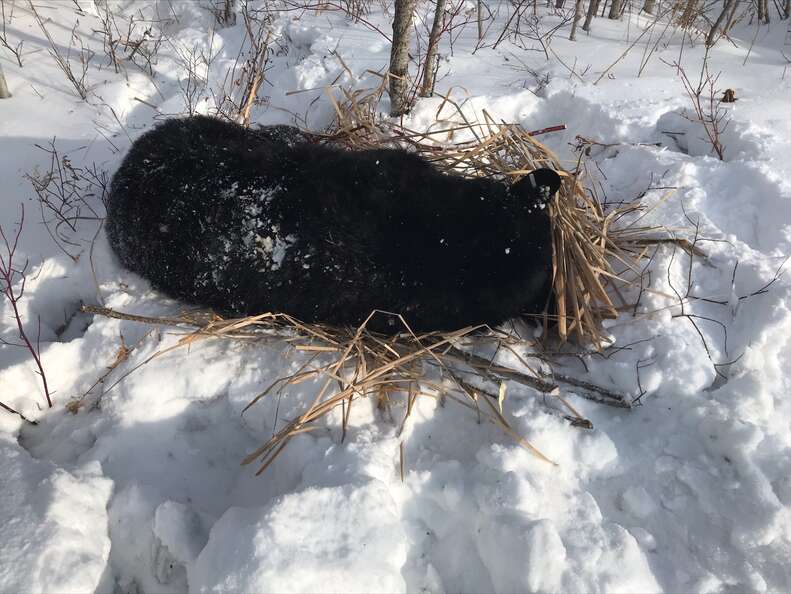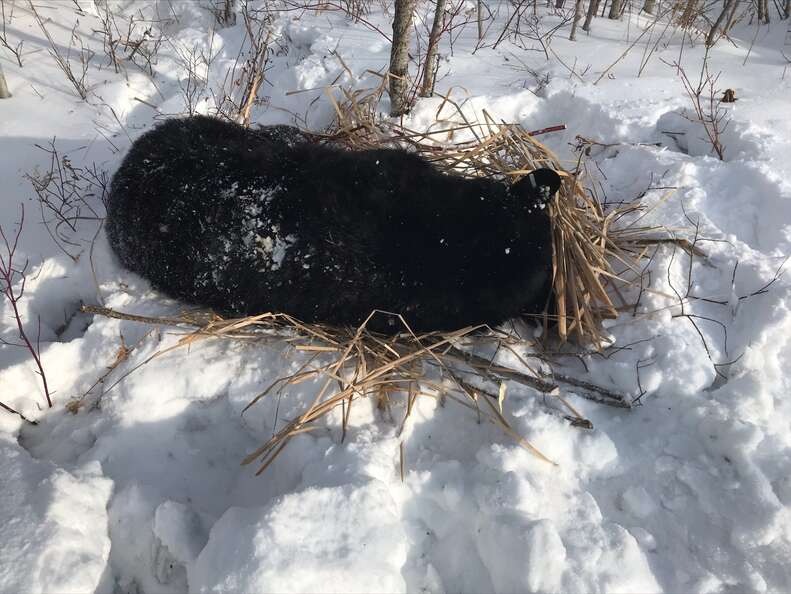A Winter’s Challenge in Wannaska
In the small town of Wannaska, Minnesota, winter is more than just cold — it is relentless, blanketing the landscape in thick layers of snow and transforming familiar surroundings into a world of white silence. Roads disappear beneath icy expanses, tree branches sag under the weight of frost, and the rhythm of daily life slows to match the cautious pace the season demands.
Yet even in this serene winter landscape, life can surprise us. One recent day, a group of drivers noticed a startling splash of black amid the endless snow. At first, it seemed like a shadow, debris, or perhaps a trick of the light. But as they drew closer, the truth became clear: a bear, stranded and struggling, had been caught in the harsh winter cold. It was a creature in urgent need of help.

The Bear in Peril
According to the Minnesota Department of Natural Resources (DNR), the bear had chosen a culvert along the roadside as a place to hunker down for the winter. While many imagine hibernation as a cozy, underground den, bears sometimes sleep above ground, seeking shelter in natural or human-made structures.
In this case, the culvert seemed like a safe retreat. But melting snow had begun to flood the area, leaving the bear trapped amid snow and ice, unable to free itself. Early attempts to help by passersby — digging or offering food — proved impossible. The bear was groggy, having been abruptly awakened from its winter rest, and its weight made amateur rescue attempts dangerous.
“Our bear biologist, Andrew Tri, examined the bear and pronounced him healthy but groggy,” the DNR reported. “Relocating a 400-pound animal safely is no small task.”

A Coordinated Community Effort
Faced with this challenge, the residents of Wannaska acted quickly and responsibly. Some called the DNR, others stayed to monitor the bear, and together they ensured the animal remained safe until professional help arrived.
Thanks to the combined effort of wildlife experts and concerned citizens, the bear was successfully freed from the flooded culvert. It was then transported to a secure location where it could continue hibernating undisturbed. While the bear may never understand the human concern that saved it, the story highlights the power of empathy and collective action.
The Lessons of Human-Wildlife Interaction
This incident serves as a reminder of the delicate balance between humans and wildlife. Roads, culverts, and other human structures can unintentionally serve as both shelter and trap for animals. Wildlife professionals stress the importance of awareness and responsible intervention when encountering animals in distress.
For northern climates like Minnesota, bears and other wildlife face harsh winters and unpredictable weather. Observant residents, timely reporting, and professional intervention can make the difference between life and harm. The story of the winter bear underscores how small, coordinated actions can prevent potentially serious situations.

A Community United by Compassion
For the residents of Wannaska, this rescue was more than just a news story — it was a shared experience that showcased the impact of compassion in action. Each person who stopped to check on the bear, called the DNR, or assisted in any way played a role in transforming a dangerous situation into one of hope and safety.
Moments like these highlight the quiet power of community. In a season often associated with isolation and hardship, the rescue of the bear brought warmth, cooperation, and a sense of shared purpose to the town.
Continuing the Winter’s Story
Today, the rescued bear sleeps safely in a secure location, its hibernation uninterrupted by floods or snowdrifts. The memory of the incident lives on in the hearts of those who helped, serving as a gentle reminder that even in the coldest, harshest environments, human kindness can have a profound effect — not only on wildlife but on communities as well.
As winter continues to blanket Minnesota, the story of the stranded bear demonstrates something universal: empathy, swift action, and a willingness to help can change lives. While the bear may resume its deep sleep unaware of the human hearts that cared, the town of Wannaska carries the warmth of that day in their memories for years to come.

Reflection: The Power of Awareness and Care
In a world that can sometimes feel indifferent, this bear’s experience reminds us of the subtle but transformative impact of compassion. Communities that come together, act responsibly, and prioritize the welfare of animals not only save lives but also cultivate a sense of shared humanity.
Every hiker, driver, or resident who notices wildlife in need can become a guardian of hope. Sometimes, the simplest acts — a call to authorities, careful observation, or reporting an animal in distress — can make all the difference. Stories like the winter bear inspire vigilance, empathy, and the quiet understanding that human care can have far-reaching effects.
Sources
-
Minnesota Department of Natural Resources (DNR) – Official report on bear rescue.
-
Legends.Feji.io – “Rescuing the Winter Bear: A Community Comes Together in Minnesota.”
-
Humane Society of the United States – Guidelines on safe wildlife interaction.
-
American Wildlife Conservation Foundation – Research on human-wildlife coexistence.
